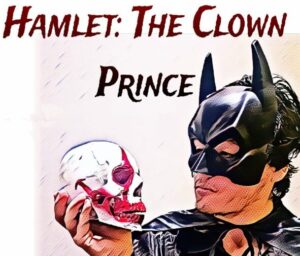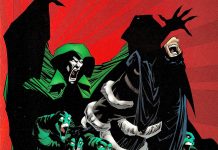Guest article by Andrew Fogel
 A deranged man with a painted white face slowly arches his back and twists his arms in choreographed rhythm. When he turns his head from side to side, you catch a glimpse of his devilish grin. This shadowy figure immersed in a symphony of chaos is not Joaquin Phoenix reprising his role as Joker but Joshuah Patriarco in the impassioned stage production of Hamlet: The Clown Prince.
A deranged man with a painted white face slowly arches his back and twists his arms in choreographed rhythm. When he turns his head from side to side, you catch a glimpse of his devilish grin. This shadowy figure immersed in a symphony of chaos is not Joaquin Phoenix reprising his role as Joker but Joshuah Patriarco in the impassioned stage production of Hamlet: The Clown Prince.
Epiphany Shakespeare Co. recently performed its innovative fusion of Shakespeare’s Hamlet with the Batman mythos in Manhattan at The Slipper Room. The spirited show is an emotional roller coaster of violence, madness, and camp set in a surreal world inspired by Tim Burton’s gloomy environs. Prince Hamlet of the medieval city of Arkham struggles to keep his sanity after his father’s ghost, who wears a menacing black mask with pointed ears, reveals that his death was not an accident but fratricide. While the king’s body is still warm, his brother Claudius steals his wife and usurps his crown. Haunted by the skull-faced apparition, the distraught prince vows to avenge his father’s murder and transforms from Bruce Wayne to the Dark Knight to the Clown Prince and back to Batman.
One may think that these narratives are strange bedfellows, but the Caped Crusader’s macabre tone and traumatic origin story compliments the revenge plot of Hamlet.
Patriarco’s unique vision mixes Shakespearean dialogue with modern language. His script pays homage to the 1966 Batman television show. Draped in Robin’s familiar colors, Horatio makes declarations in the style of Burt Ward. Some memorable jests Geneva Turner delivers while wearing a red tunic and yellow cape include “Holy Hallucination!,” “Holy Batface!,” and “Holy Fratricide!” The Batman movies feature prominently, too. Douglas Keller often steals the limelight with his comedic relief as Rosencrantz. “Allow me to break the ice,” he says as Mister Freeze in Arnold Schwarzenegger’s voice. Hamlet, during his calculated bout of insanity as Joker, gets an unexpected laugh from the crowd when he jabs the foot soldier with the moniker “Frozencrantz.”
Batman’s cinematic canon provides more than just comedy. Hamlet solidifies his transformation into the Joker persona with Jack Nicholson’s legendary line: “You ever danced with the devil in the pale moonlight?” But when spoken a second time in relation to Heath Ledger’s version it loses its luster and confuses franchises. While Patriarco draws a shrewd parallel between Claudius’s violent interrogation of Hamlet and Batman’s confrontation with Joker in The Dark Knight, Nicholson’s armed threat does not gel as a maniacal taunt from Ledger’s psychotic clown. Patriarco’s integration of part of Ledger’s “Why so serious?” speech in the nunnery scene is a better marriage. The dialogue underlines the psychological abuse Polonius inflicts over his daughter Ophelia, played by company cofounder Samantha Mileski.
All the players in Hamlet’s world correspond to a character in Batman’s universe. Patriarco’s script incorporates puzzles in Polonius’s pontifications to cement his position as Riddler. Ophelia’s breakdown aided by Hamlet’s self-destructive behavior mirrors Harley Quinn’s own madness and moral corrosion at the hands of Joker. Laertes as Two-Face and Guildenstern as Mad Hatter are the least clear correlations but help round out the Batverse.
The cast actualizes the dual identity nature of the production and presents Hamlet through the lens of Batman’s fictional world. Chantez Engeleit channels feline energy into her role as Queen Gertude. Her animalistic movements and mannerisms evoke Catwoman—imagine a cross between Eartha Kitt and Michelle Pfeiffer as she raises her claws in conversation and threatens to scratch. Gertude’s death commemorates Catwoman’s nine lives defense in Batman Returns. As Max Shreck blasts Catwoman with bullets, she says: “Six, seven, all good girls go to heaven.” The movie dialogue likely borrowed from the Beatles’ Abbey Road medley classic “You Never Give Me Your Money.” Paul McCartney incorporates the British circle game “All Good Children Go to Heaven” into his song. As Patriarco told me, “Art and pop culture is all recycled.”
Michael D. Espindle shines in his brief but memorable portrayal of Osric as Poison Ivy. Playing her in drag was most unexpected and brought another level of levity.
The playwright gives a captivating performance as he moves between three characters and physically bounces across the stage as the Dark Knight. With all these elements, Patriarco still finds room to impart a dose of Marlon Brando’s brooding from A Streetcar Named Desire and mania from Apocalypse Now to his tripartite Hamlet. The script even sprinkles a little Nicholson from The Shining with the line “Here’s Hammy!” to intensify the suspense. He wears not just the masks of Joker and Batman but the Greek pair of Melpomene and Thalia. (To aid the audience in the transition from Bruce Wayne to Joker a prop could be helpful; a simple solution might be to dramatically pin a flower to his jacket.)
Thomas Annunziata presents an equally stirring performance. Be prepared to get a jolt when he breaks the fourth wall by jumping off stage as the ghost of Hamlet’s father. Annunziata draws the audience deeper into the story when he stalks the room. His physicality and eeriness as the “Bat-ghost” sets the tone along with the accompanying musical choices. And his portrayal of Claudius as a mob boss conveys the same imposing stage presence. Close your eyes and you can see that Vincent D’Onofrio’s rendition as Kingpin in the Netflix show Daredevil inspired Annunziata’s vocal inflection and gait for Penguin. (The umbrella as a cane is a clever addition to the role, and Claudius chokes Hamlet with the prop during the interrogation scene.) Annunziata’s take on D’Onofrio is a little too on the nose, nevertheless. More of the actor’s own voice in the character is preferable to mimicry.
The production is extremely intimate. Like Bat-ghost, Hamlet and Horatio storm off stage to further dissolve the fourth wall. This dimension might be a carryover from the company’s first run of the show in a dinner theater setting. These scenes use the entire space to situate the audience in the surreal world and the script should lean into this ambiance by having the other performers do the same.
Yet Hamlet: The Clown Prince is most memorable for its sword fighting. The climactic scene of Hamlet’s duel with Laertes pays tribute to Douglass Fairbanks’ portrayal of Zorro, Bob Kane’s main inspiration for the caped avenger. The cartoonist, known to bend the truth and downplay the contributions of Bill Finger and Jerry Robinson, recalls in his memoir the impact of the movie star and The Mark of Zorro on his younger self. Patriarco taps into this history with the help of fight choreographer Erin Herbert, who makes their blades dance. Imagine Hamlet as Adam West and Fairbanks rolled into one.
Patriarco’s mash-up is a creative fusion of highbrow and lowbrow. It speaks to the trend of blockbuster movies adapted to Broadway musicals like Beetlejuice and Back to the Future. The play offers all the depth of Hamlet and childhood wonder of Batman. Traditionalists might find the interpretation sacrilegious but superhero fans with a penchant for the Western literary canon or an openness to relive their high school English required reading will relish the literary license. A refresher course on Hamlet is helpful but not necessary to digest the sophisticated and fun narrative. – Andrew Fogel
Andrew Fogel is a historian of popular culture whose research and writing explores the power of the superhero fantasy over the American imagination for both kids and adults. He completed his doctorate at Purdue University.











